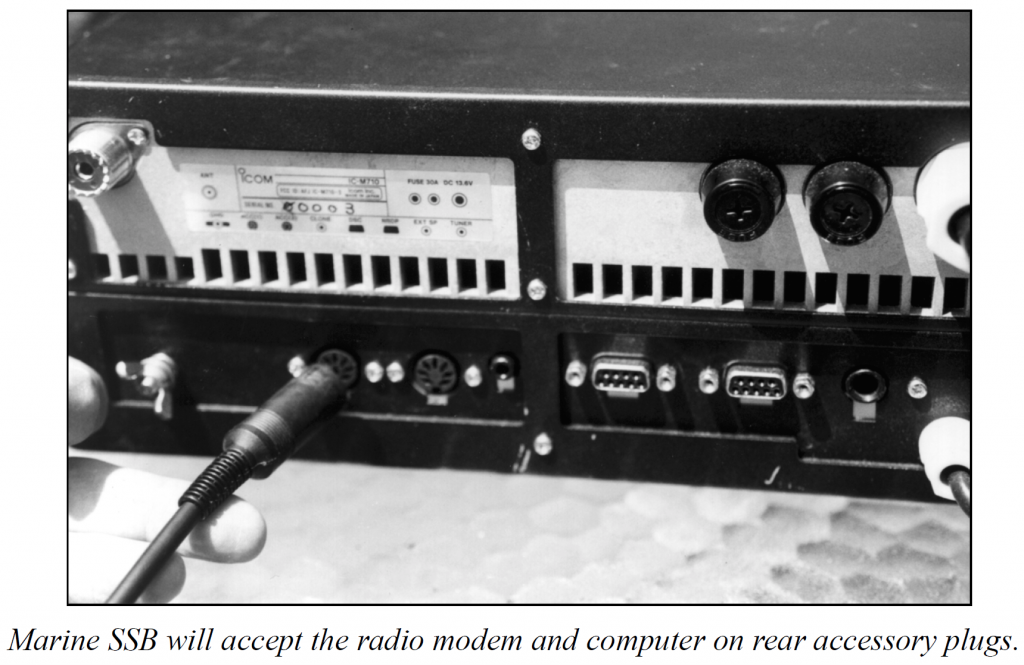
Your new SSB transceiver may have many channels designated for narrow-band direct printing (NBDP). These are frequencies for simplex telex over radio (SITOR) which has been the established mode of maritime communications for the merchant shipping industry for more than 50 years. SITOR is electronic e-mail over marine frequencies. All you need is a computer and a radio modem to complete the marriage to your marine SSB. With this equipment, you will be able to send and receive e-mail over worldwide frequencies.
Using your lap-top computer and a special modem and your new ICOM SSB, you can send and receive written text messages far more efficiently than voice messages. Written messages allow you to think through what you want to say ahead of time, format your message off-line in your computer, and then send it off with a few keystrokes, right from your vessel at anytime, day or night, anywhere in the world. Your SITOR one-third page of text can go in less than 2 or 3 minutes or often less than the minimum air time voice telephone charge. If you have several pages of text, it could take up to 10-30 minutes, but you are assured of “solid copy” at the other end of the circuit. You can also receive e-mail as well. Inbound traffic for your vessel is saved in your vessel’s own mailbox in the host computer until you are ready to receive it. People on shore can access the system by the Internet, or any one of the several commercial e-mail system such as CompuServe, AOL, Telex, FAX, or voice transcription, using the public telephone system via any of the common carriers. You can also use your computer and your SSB to receive, free of charge, weather facsimile imagery directly from the Coast Guard. You can also receive high-quality weather forecast charts in your mailbox for downloading at your convenience through private yacht weather forecasting companies.
Electronic e-mail over marine SSB circuits are carried on by more than 200 radio telex shore stations in the world as described in the admiralty list of radio signals. All of these worldwide data stations have been coordinated in respect to international billing arrangements for ships of all nations which wish to connect to any foreign coast station along the route of their voyage. Two companies, Globe Wireless (now Inmarsat), and PinOak Digital* offer worldwide networks of pickup and relay stations with only one administration to deal with as you make your international voyage. These networks, of high-frequency coast radio stations are designed to provide both spacial and frequency-diverse channel capacity to all mariners around the globe. Multiple propagation paths together with automated control of the ship’s existing high-frequency SSB radio system provide transmission quality and link availability not previously obtainable on similar voice circuits. Traffic lists, message traffic, and other data services are sent throughout all of the world wide network e-mail stations, and downloaded easily with your shipboard lap-top computer.
The typical cost for a SITOR message is about $2.00 a minute, where approximately 300 characters can be sent per minute. This works out to be about three cents per word. If you plan to send high volumes of data on your computer on an almost daily basis, PinOak Digital and Globe Wireless offer other types of high speed data transfer systems that allow you to send and receive messages in about one-tenth the time as normal SITOR.
Did You Know?For more information about the Globe Wireless e-mail connection to your ICOM SSB, contact Globe Wireless at (800) 876-7234. For more information about PinOak Digital High Frequency Digital Communications, call (800) 746-625l. For more information about SAILMAIL visit their website at www.sailmail.com
*It appears PinOak Digital are no longer in businesses or have been bought out, I can not find any link to a business.